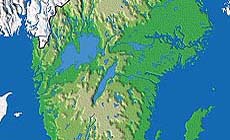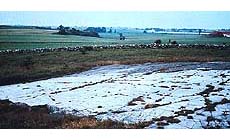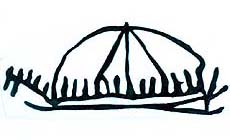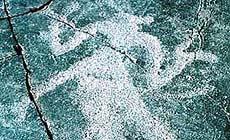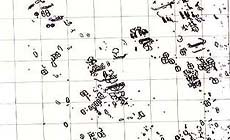|
|
 |
 |
Country: |
Sweden |
Locality: |
Järrestad |
|
 |
Region: |
Skåne |
Area: |
Järrestad |
|
 |
 |
|
|
|
|
| |
 |
Environment & Surface |
 |
 |
 |
|
Open-air
Shelter
Cave
Portable
Megalithic
|
Geography: |
Wide, flat slighlty sloping rock. Plain. |
Proximity: |
300 m Nof farm (Vilhelmsberg), 150 m W of road to Järrestad-Gladsax. |
|
 |
Geology: |
Blue-greyish quartzite. |
Surface: |
Very, smooth almost flat surface. Cracks and exfoliation. |
|
Dimensions:
|
Length 23.00 m.
Width 22.00 m.
|
|
 |
 |
|
|
|
|
| |
 |
Art |
 |
 |
 |
Description: |
Engravings
Paintings
Painted engravings
High or low-relief
Sculpture
Järrestad no 4, Järrestad parish. A large carving with a total number of 1267 figures, which makes it one of the larger localities in Scandinavia. A large number of the figures are cup marks and contour-carved foot prints, and the number of ship figures are low. The carving has probably came about during a very long period of time, and consist of a number of the few megalithic ornaments in Sweden. Possibly from the Middle Neolithic; the double-spiral, snake-figures, u-signs and zigzag patterns. There are a number of dolmens and passage graves in the area. Many of the older figures have been superimposed by new pictures, above all many of the weapons depicted. Mayby to remove the "power" from the older tradition. A number of the figures at Järrestad are shafted daggers with blades made of flint of a type familiar in Scania during the Stone Age. The few ship figures most probably belong to the Bronze Age, so does the big human figure at the base of the rock, "the Dancer". There are two figure of special interest, the two standing horsemen in the left part of the rock, with the reins leaping in a bow over the heads of the horses. The same way of depicting the reins are known also from the chariot-scene at slab no 7 in the Kivik tomb.
|
Figures: |
total number 1267
Ship figures/single-lined with crew strokes/double-lined with crew strokes/double-lined without crew-strokes/single-lined without crew strokes/with sail/with animal-head decoration at the prow
Human figures
Horses
Foot prints/totally carved out with toes/contour-carved with heel/without heel
Weapon/shafted axes/shafted daggers
Snake-figures
Double spiral
Zigzag patterns
Wheel cross
Cup marks
Obscure figures
|
|
 |
Chronology: |
Palaeolithic
Epipalaeolithic - Mesolithic
Neolithic
Copper Age
Bronze Age
Iron Age
Roman
Middle Age
Modern
Unknown
The Scanian rock carvings differ from those elsewhere in Scandinavia, the majority belongs to the close of the Stone Age, c. 2000 BC. The weapon figures can be dated to this period, and had their counterparts in the carvings of Central Europe. Some figures might even be older, especially those with similarities in the Megalithic ornamentation of the Middle Neolithic, c. 3200-2500 BC.
|
Notes: |
The Järrestad carving is exceptional in both the number of figures and the figurative content. Especially the many naturalistic foot prints are interesting, one is struck by the realism of the depiction; these are real foot prints. Also the large figure called "The Dancer" is special in the rock carving tradition, and gives a good example of how well the mode of depiction has been appreciated. Notable are the megalithic ornaments at Järrestad, linking Scania with the megalithic traditions of the British Isles and Western Europe (Burenhult 1989:64f). |
|
 |
 |
|
| |
 |
Bibliography |
 |
|
|
|
|
| |
 |
Conservation |
 |
 |
 |
Status: |
Public
Private
Park
Classified site
|
Risk: |
The rock carvings are fragile and the major risk are chemical weathering, which makes the hard quartzite losen up and fall out, leaving white dots on the darker rock surface. Also natural weathering (mechanical weathering) during winter/spring, when water freeze in cracks and openings in the rock, creates major damage to rock faces with carvings. The biological weathering is also a danger to the rock carvings, and even to intense cleaning of the rock surface during documentation can make the rock fragile and expose the carvings to wind, water and air-born pollution. |
|
 |
Conservation: |
Good
Quite good
Mediocre
Bad
|
Intervention: |
Problems concerning conservation and preservation, registration and documentation of rock carvings in Scandinavia are discussed by several departments, i.e. Riksantikvaren in Norway, Riksantikvarieämbetet in Sweden, several universities and research departments. Different methods are tested, for example covering of carved surfaces, measuring of temperature and different contents in water and air and also the composition in the granite. Hollows and cracks in the rock surface can be repaired and carefully filled in. |
|
 |
 |
|
|
 |
By |
 |
|
| |
| Record n. 768 / 807 |
No commercial use is allowed. Specific © is mentioned in the captions or owned by each Author or Institution |
|
| |
 |
EuroPreArt, European Prehistoric Art, is a web-based archaeological project funded by the European Union which aims to establish a lasting data-base of European prehistoric art documentation, to launch the base of an European institutional network and to contribute to the awareness of the diversity and richness of European Prehistoric Art.
It is proposed by: Instituto Politécnico de Tomar (IPT, Portugal),
CUEBC - European University Centre for Cultural Heritage (Italy - Europe),
Consejo Superior de Investigaciones Científicas (España),
Asociación Cultural Colectivo Barbaón (España),
Université de Liège (Belgique),
Gotland University College (Sverige),
University College Dublin (Eire),
Cooperativa Archeologica Le Orme dell'Uomo (Italia),
Study Centre and Museum of Prehistoric Art of
Pinerolo (Italia),
The European Centre for Prehistoric Research in the Alto Ribatejo (Portugal),
ArqueoJovem - a youth NGO (Portugal).
|
|
|
|
 |
|
 NEW: Alpine rock paintings
NEW: Alpine rock paintings